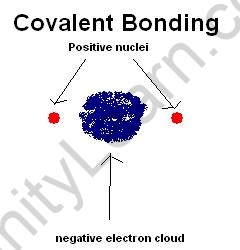Table of Contents
Depending on the electronegativity difference between the atoms involved, covalent bonds can be polar or nonpolar. The lengths of covalent bonds between various atoms vary.
A nonpolar covalent link is a type of chemical connection produced when two atoms share electrons evenly. As a result, the number of electrons shared by neighbouring atoms in an atom will be the same.
Because the difference in electronegativity is usually minimal, the covalent bond is sometimes referred to as nonpolar. It also implies that there is no charge gap between the two atoms or that both atoms have similar electronegativity. When atoms that share a polar connection organize themselves in such a way that their electric charges cancel each other out, this sort of bond is generated.
A nonpolar covalent bond can form between two non-metal atoms that are the same or different.

Nonpolar Covalent Compounds
- Nonpolar covalent compounds are those in which there is no variation in electronegativity.
- There is no change in electronegativity in these compounds, hence there is no mobility of the bond pair of electrons towards the bound atoms.
- As a result, there is no connection or dipole moment between the atoms of a molecule, and no charge development on the atoms, making the molecule nonpolar and non-conducting.
Nonpolar Covalent Compound Properties
- Physical State: These exist mostly as gases and to a lesser extent as liquids.
- Natural: These are really soft.
- Solubility: These are either insoluble in water or have a low solubility in water. However, they are more soluble in nonpolar solvents such as CCl4, CHCl3, and so on.
- Conductivity: Because there are no charged particles, they are insulators.
- Boiling And Melting Points: Because there is no interaction or polarity, they have very low boiling and melting points.
- Dipole moment: Because the connection is no longer polar, it has zero dipole moment.
Nonpolar Solids Examples
He, Ne, Ar, Benzene, H2, N2, O2, Cl2, Carbon dioxide, Methane, and so on are some popular examples. All of them exhibit zero dipole moment rather than polarity in their bonds.
Differences Between Polar And Non-Polar Covalent Solids
Polar and nonpolar covalent solids have different properties.
-
Solids with Polar Covalent Bonds
- These can be solids or liquids.
- These are more water-soluble.
- These are insoluble in benzene, chloroform, and other solvents.
- Excellent heat and electricity conductors.
-
Solids with Nonpolar Covalent Bonds
- These are primarily gases.
- These are water-insoluble.
- Insulators are soluble in chloroform.
- Between the atoms, London dispersion forces occur.
FAQs
Why is the dipole moment in nonpolar materials zero?
Because there are no forces of attraction or binding moments between the atoms in the molecules, the dipole moment is zero.
Why are nonpolar solids insulators?
They are classified as insulators because there is no ionization between the particles, hence no charge-carrying ions exist.
What is the sort of intermolecular force that exists between nonpolar solids?
There are London dispersion forces between nonpolar substances.
Why are there no bond moments in a hydrogen molecule?
Because the electronegativity of hydrogen atoms is the same.









